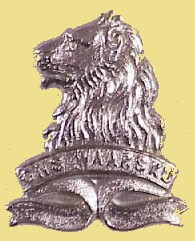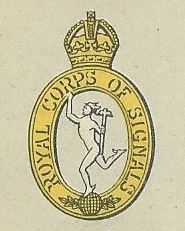The South African 2nd Infantry Division was an infantry division of the army of the Union of South Africa during World War II. The division was formed on 23 October 1940 and served in the Western Desert Campaign and was captured by German and Italian forces at Tobruk on 21 June 1942. The remaining brigade was re-allocated to the South African 1st Infantry Division.
45 Commando Royal Marines is a battalion sized unit of the British Royal Marines and subordinate unit within 3 Commando Brigade Royal Marines, the principal Commando formation, under the Operational Command of the Fleet Commander.

The Cheshire Regiment was a line infantry regiment of the British Army, part of the Prince of Wales' Division. The 22nd Regiment of Foot was raised by the Duke of Norfolk in 1689 and was able to boast an independent existence of over 300 years. The regiment was expanded in 1881 as part of the Childers Reforms by the linking of the 22nd (Cheshire) Regiment of Foot and the militia and rifle volunteers of Cheshire. The title 22nd (Cheshire) Regiment continued to be used within the regiment.

The Dorset Regiment was a line infantry regiment of the British Army in existence from 1881 to 1958, being the county regiment of Dorset. Until 1951, it was formally called the Dorsetshire Regiment, although usually known as "The Dorsets". In 1958, after service in the Second Boer War along with World War I and World War II, the Dorset Regiment was amalgamated with the Devonshire Regiment to form the Devonshire and Dorset Regiment. In 2007, it was amalgamated with the Royal Gloucestershire, Berkshire and Wiltshire Regiment, The Light Infantry and the Royal Green Jackets to form a new large regiment, The Rifles.

The South Wales Borderers was a line infantry regiment of the British Army in existence for 280 years.

The Royal Inniskilling Fusiliers was an Irish line infantry regiment of the British Army in existence from 1881 until 1968. The regiment was formed in 1881 by the amalgamation of the 27th (Inniskilling) Regiment of Foot and the 108th Regiment of Foot.

The Cameronians was a rifle regiment of the British Army, the only regiment of rifles amongst the Scottish regiments of infantry. It was formed in 1881 under the Childers Reforms by the amalgamation of the 26th Cameronian Regiment and the 90th Perthshire Light Infantry. In 1968, when reductions were required, the regiment chose to be disbanded rather than amalgamated with another regiment, one of only two infantry regiments in the British Army to do so, with the other being the York and Lancaster Regiment. It can trace its roots to that of the Cameronians, later the 26th of Foot, who were raised in 1689. The 1881 amalgamation coincided with the Cameronian's selection to become the new Scottish Rifles.

The Andrew Mlangeni Regiment is a reserve infantry regiment of the South African Army.

The Johannesburg Light Horse Regiment, is a reserve armoured car reconnaissance unit of the South African Army.

The East Surrey Regiment was a line infantry regiment of the British Army in existence from 1881 until 1959. The regiment was formed in 1881 under the Childers Reforms by the amalgamation of the 31st (Huntingdonshire) Regiment of Foot, the 70th (Surrey) Regiment of Foot, the 1st Royal Surrey Militia and the 3rd Royal Surrey Militia.

The East Yorkshire Regiment was a line infantry regiment of the British Army, first raised in 1685 as Sir William Clifton's Regiment of Foot and later renamed the 15th Regiment of Foot. It saw service for three centuries, before eventually being amalgamated with the West Yorkshire Regiment in 1958, to form the Prince of Wales's Own Regiment of Yorkshire. Subsequently, the regiment amalgamated with the Green Howards and the Duke of Wellington's Regiment to form the Yorkshire Regiment on 6 June 2006.

The Suffolk Regiment was an infantry regiment of the line in the British Army with a history dating back to 1685. It saw service for three centuries, participating in many wars and conflicts, including the First and Second World Wars, before being amalgamated with the Royal Norfolk Regiment to form the 1st East Anglian Regiment in 1959 which, in 1964, was further amalgamated with the 2nd East Anglian Regiment, the 3rd East Anglian Regiment and the Royal Leicestershire Regiment to create the present Royal Anglian Regiment.

The Perth Regiment was an infantry regiment of the Canadian Army. It is currently on the Supplementary Order of Battle.
The South African 1st Infantry Brigade was an infantry brigade of the army of the Union of South Africa during World Wars I and II. During World War I, the Brigade served as a British formation in Egypt and on the Western Front, most famously the Battle of Delville Wood. It was reactivated at the start of the Second World War as a South African formation and served in East Africa and the Western Desert; the Brigade disbanded on 1 January 1943.

The General de la Rey Regiment is an reserve infantry regiment of the South African Army.
Hendrik Frederik Prinsloo, OBE, ED was a South African army officer. As a 12-year-old boy, he was interned by the British in a concentration camp during the Anglo-Boer War but served alongside the British in the South African forces during the two World Wars. He is best remembered for the humanitarian manner in which he, as commandant, ran the Zonderwater Italian prisoner of war camp.
The 1919 Birthday Honours were appointments by King George V to various orders and honours to reward and highlight good works by citizens of the British Empire. The appointments were made to celebrate the official birthday of The King, and were published in The London Gazette from 3 June to 12 August. The vast majority of the awards were related to the recently ended War, and were divided by military campaigns. A supplementary list of honours, retroactive to the King's birthday, was released in December 1919.

Regiment Louw Wepener was an infantry battalion of the South African Army. As a reserve force unit, it had a status roughly equivalent to that of a British Army Reserve or United States Army National Guard unit.

The Hull Pals were a brigade of four battalions of the East Yorkshire Regiment raised as part of Kitchener's Army in 1914. They served in 31st Division at Serre on the first day of the Battle of the Somme in 1916, though they escaped the worst of the disaster. However, they suffered heavy casualties in the same area later in the year, and again at Oppy Wood in early 1917. They continued to serve on the Western Front for the rest of the war, including hard fighting against the German spring offensive and in the final Hundred Days Offensive.

1st Armoured Division Signals was a unit of Britain's Royal Corps of Signals providing communications for the 1st Armoured Division during the Second World War. It was present during the Battle of France, the Western Desert Campaign, including the battles of Gazala and Alamein, the Tunisian Campaign, and the Battle of Coriano during the Italian Campaign.















